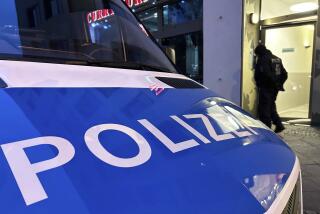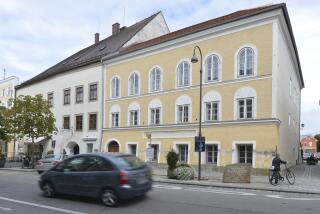Bonn Sets Up Dragnet for Assassins : Terrorism: The government offers $2 million for information on the killers of Alfred Herrhausen. He was an internationally known banking figure.
- Share via
BONN — West German police threw up a nationwide network of roadblocks Friday in an effort to intercept two men suspected of assassinating the banker Alfred Herrhausen.
The government posted rewards totaling $2 million for information that would lead authorities to the killers.
In Frankfurt, the country’s financial capital, about 10,000 bank employees and others marched silently through the streets in a tribute to Herrhausen, an internationally known banking figure and chief executive of West Germany’s largest financial institution, the Deutsche Bank.
A spokesman for the federal prosecutor’s office, Hans-Juergen Foerster, said the search focused on two men seen at the site of the killing, which took place Thursday in Bad Homburg, a Frankfurt suburb where Herrhausen lived.
He said one of the two had been tentatively identified as Christoph Seidler, 31, who has been involved with the Red Army Faction for more than 10 years and is wanted in connection with a 1985 bank robbery.
Seidler, he said, was a member of the “hard core” of the group, which has terrorized West Germany for more than a decade with abductions, assassinations and attacks on military installations.
Herrhausen’s car, an armored BMW, was blown up by a massive charge detonated by a complex arrangement not known to have been used in previous guerrilla attacks. The blast, which was heard for miles around, destroyed the car and severely wounded the driver.
Foerster said the two men being sought were observed leaving the scene in a car that was later found abandoned in Frankfurt. The fact that it had been rented more than a month ago led authorities to believe that the killers had been planning the attack for some time.
Another official in the prosecutor’s office said the killers began their preliminary work “at least four or five weeks ago.”
“Near the area of the attack,” he said, “wires had been buried in the asphalt. The asphalt had been chiseled out . . . and after the wires were laid it was filled in.”
He said the wires were attached to lights that threw a beam across the path of Herrhausen’s car, and when the beam was broken an explosive charge was detonated.
The killers took care, he said, to color the asphalt to disguise their work.
Near the bombing site, the police found a letter bearing the Red Army Faction symbol--a Kalashnikov rifle superimposed on a five-pointed star. The letter’s contents have not been made public.
West German officials said the attack was apparently meant to signal that the Red Army Faction, an organization with anti-capitalist aims, is still a force to be reckoned with.
Commentators speculated that Herrhausen, a friend and adviser to West German Chancellor Helmut Kohl, may have been targeted because of his association with the arms industry. He was involved in the recent merger of the auto maker Daimler-Benz with the aerospace and arms company Messerschmidt-Boelkow-Blohm--now the country’s largest defense conglomerate.
Finance Minister Theo Waigel appeared to endorse this reasoning in an address on the floor of Parliament. He said the killing was “an escalation of the irresponsible talk of the dominance of a military-industrial complex.”
A controversy has developed over whether Herrhausen had adequate protection.
The prosecutor’s office said there will be a review of security arrangements for leading public figures.
Security officials have suggested that the Red Army Faction, which was particularly active in the 1970s, has no more than 20 or 30 active members today. But Christian Lochter, head of the Hamburg branch of West Germany’s counterintelligence service, said Friday that he thought the organization’s “commando” unit might be able to recruit from a pool of as many as 250 sympathizers.
He said the terrorists were angered by the euphoria that has swept West Germany in connection with the opening of the Berlin Wall and may have killed Herrhausen because they thought West Germany might try to persuade East Germany and other Communist countries to become more capitalistic.
Until Thursday, the group had scarcely been heard from since 1968, when it took the responsibility for the killings of Karl Heinz Beckurts, an executive of the huge industrial firm Siemens, and Gerold von Braunmuehl, a diplomat.
Still, it is believed to have been involved in a failed effort last year to kill Hans Tietmeyer, an official in the West German Finance Ministry.
More to Read
Sign up for Essential California
The most important California stories and recommendations in your inbox every morning.
You may occasionally receive promotional content from the Los Angeles Times.













